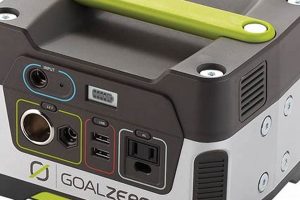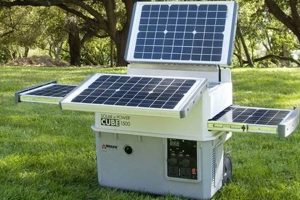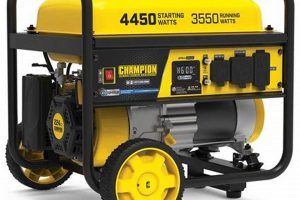Small, self-contained devices capable of generating electricity are vital for a variety of applications. These compact units offer independent power solutions for situations ranging from recreational activities like camping and tailgating to emergency preparedness scenarios where grid power is unavailable. For instance, a device might use gasoline, propane, or solar energy to power small appliances, electronic devices, and lighting.
The ability to produce electricity on demand and independent of traditional power sources has become increasingly important in modern society. These compact power sources provide critical backup power during outages, supporting essential functions and communication. Moreover, their portability makes them ideal for outdoor recreational activities and remote work locations, offering a reliable energy source where conventional power access is limited or nonexistent. The evolution from bulky, noisy generators to these smaller, quieter, and more efficient models has broadened their applicability and appeal significantly.
This article explores the various types of these power solutions available, their respective functionalities, key features to consider during selection, and essential safety guidelines for operation and maintenance. Further sections will delve into specific applications and address common questions regarding their use.
Tips for Selecting and Using Compact Power Generators
Careful consideration of several factors ensures optimal performance and longevity of independent power sources. The following tips offer guidance on selecting, operating, and maintaining these devices.
Tip 1: Determine Power Needs: Calculate the wattage required to run the intended devices simultaneously. This information is crucial for selecting a unit with sufficient output capacity. Appliance wattage can typically be found on a label or in the owner’s manual.
Tip 2: Consider Fuel Type: Gasoline, propane, and solar power offer distinct advantages and disadvantages. Gasoline models are often more powerful but require fuel storage and maintenance. Propane is generally cleaner-burning and easier to store. Solar generators are a sustainable option, but their output can be weather-dependent.
Tip 3: Evaluate Runtime: Assess the required operating time on a single charge or fuel tank. Longer runtimes are essential for extended outages or remote operations.
Tip 4: Assess Portability: Weight and size are critical factors, particularly if the unit needs to be transported frequently. Consider features like handles, wheels, and compact design for ease of mobility.
Tip 5: Prioritize Safety Features: Look for features such as overload protection, low-oil shutdown, and automatic voltage regulation to safeguard connected devices and ensure safe operation.
Tip 6: Understand Maintenance Requirements: Regular maintenance, including oil changes, air filter cleaning, and proper storage procedures, is crucial for optimal performance and longevity.
Tip 7: Research Noise Levels: Operating volume can be a significant factor, especially in residential areas or noise-sensitive environments. Look for models with lower decibel ratings for quieter operation.
Selecting a unit based on these guidelines ensures reliable power generation and a longer lifespan for the device. Adherence to safety and maintenance recommendations maximizes efficiency and user safety.
By understanding the various aspects of compact power generation, individuals can make informed decisions and utilize these devices effectively for various applications. The concluding section offers a summary of key considerations and reinforces safe operating practices.
1. Power Output
Power output, measured in watts, is a critical specification for compact power generators. It directly determines the types and number of devices that can be powered simultaneously. Understanding power output is essential for selecting a generator that meets specific needs, whether for recreational use, emergency backup, or professional applications.
- Rated Power (Running Watts):
This represents the continuous power output the generator can sustain for an extended period. For example, a generator with a rated power of 1000 watts can reliably power a 700-watt microwave oven and a 200-watt lamp simultaneously. Choosing a generator with sufficient rated power is crucial to avoid overloading and potential damage to both the generator and connected devices. Exceeding the rated power can lead to performance issues and even permanent damage.
- Surge Power (Starting Watts):
Certain devices, such as refrigerators and power tools, require a higher initial surge of power to start. Surge power, often considerably higher than the rated power, indicates the generator’s capacity to handle these temporary power demands. For example, a refrigerator requiring 1800 starting watts but only 700 running watts necessitates a generator capable of supplying that initial surge. Neglecting surge power requirements can result in the generator failing to start connected appliances.
- Power Output and Fuel Consumption:
Higher power output typically correlates with greater fuel consumption. A larger generator capable of powering more devices will generally use more fuel per hour than a smaller, less powerful unit. This relationship underscores the importance of carefully assessing power needs to optimize fuel efficiency and minimize operating costs.
- Matching Power Output to Device Requirements:
Accurately calculating the combined wattage of intended devices is paramount. Adding up the wattage requirements of all devices planned for simultaneous use ensures the selected generator has ample power output. This process may involve checking appliance labels, consulting user manuals, or using online wattage calculators. Failing to accurately assess power needs can result in insufficient power supply or unnecessary fuel consumption from an oversized generator.
Careful consideration of power output specifications ensures the selection of a compact generator that effectively meets specific power demands. Understanding the distinctions between rated power and surge power, along with the relationship between power output and fuel consumption, leads to informed decisions that maximize performance and efficiency while safeguarding connected devices.
2. Portability
Portability is a defining characteristic of compact power generators, directly influencing their usability and suitability for various applications. The ease with which these devices can be transported and deployed is a key factor in their appeal, especially for activities like camping, tailgating, and emergency preparedness. Understanding the elements that contribute to portability helps users select the most appropriate generator for their specific needs.
- Weight and Dimensions:
The physical size and weight of a generator significantly impact its portability. Smaller, lighter units are easier to carry, transport in vehicles, and maneuver in tight spaces. For instance, a lightweight model with a built-in handle is ideal for camping trips, while a heavier unit with wheels might be more suitable for tailgating or construction sites. Weight and dimensions should be carefully considered based on the intended use and the user’s physical capabilities.
- Form Factor and Design:
The overall design and form factor contribute to portability. Compact, integrated designs with recessed handles or integrated wheels enhance ease of movement. Some models feature foldable handles or removable components for more compact storage. These design elements can significantly impact the user experience, particularly when transporting the generator over uneven terrain or storing it in limited space.
- Handle and Wheel Configuration:
The presence and design of handles and wheels are essential for larger, heavier units. Ergonomic handles and durable wheels facilitate transport across various surfaces. Telescoping handles and never-flat wheels further enhance maneuverability. For users needing to transport generators up stairs or over rough terrain, these features become crucial for safe and convenient handling.
- Integrated Storage and Accessories:
Some portable generators offer integrated storage compartments for cables, tools, and other accessories. This feature contributes to overall portability by keeping essential components organized and readily accessible. Dedicated storage compartments minimize the need for separate carrying cases and streamline the setup process, particularly in outdoor or remote locations.
The portability of a compact power generator directly influences its practicality and suitability for different scenarios. Careful consideration of weight, dimensions, design features, and storage solutions ensures users select a generator that aligns with their mobility requirements and intended applications. Prioritizing portability enhances the overall user experience, making these power solutions more versatile and convenient.
3. Fuel Source
Fuel source is a fundamental aspect of mini portable power generators, directly impacting their functionality, environmental impact, and operational costs. The choice of fuel source significantly influences the generator’s suitability for specific applications and user requirements. Understanding the various fuel types available and their respective characteristics is crucial for informed decision-making.
Common fuel sources include gasoline, propane, and solar energy. Gasoline-powered generators offer high power output and widespread fuel availability, making them suitable for demanding applications and emergency situations. However, gasoline storage requires careful handling due to flammability and potential degradation over time. Propane generators provide a cleaner-burning alternative with longer shelf life for stored fuel, making them attractive for recreational use and situations where emissions are a concern. Solar-powered generators represent the most environmentally friendly option, utilizing renewable energy and producing no emissions during operation. However, their output can be weather-dependent, requiring sunlight or battery storage for consistent power generation. The selection of a fuel source requires careful consideration of factors such as power needs, environmental impact, fuel availability, and storage practicality.
For example, a construction site might benefit from a gasoline-powered generator due to its high power output and readily available fuel. Campers might prefer the cleaner-burning and easier-to-store propane option. Individuals seeking environmentally conscious solutions or operating in remote, off-grid locations might find solar-powered generators ideal. Understanding the advantages and disadvantages of each fuel source ensures selection of a generator that aligns with specific needs and operational circumstances. This informed decision-making process optimizes generator performance while minimizing environmental impact and operational costs.
4. Runtime
Runtime represents a critical performance metric for mini portable power generators, signifying the duration a unit can operate continuously on a single fuel charge or battery cycle. This duration directly impacts the generator’s practicality and suitability for various applications. Understanding the factors influencing runtime and its practical implications is essential for effective generator selection and utilization.
Several factors influence a generator’s runtime. Fuel tank capacity or battery size directly correlates with potential runtime. The load placed on the generator, determined by the power consumption of connected devices, also plays a significant role. Higher power demands generally result in shorter runtimes. Operating conditions, such as ambient temperature and altitude, can also affect runtime. For instance, a generator powering essential appliances during a power outage might require a longer runtime than one used for recreational purposes like tailgating. A generator with a larger fuel tank and efficient power management features would be better suited for extended operation during emergencies.
Practical considerations for runtime include assessing power needs and anticipated usage duration. For extended outages or remote operations, maximizing runtime through larger fuel tanks, efficient operation, or supplemental power sources becomes crucial. Conversely, shorter runtimes might suffice for recreational activities or backup power for shorter durations. Understanding the interplay between fuel capacity, load, operating conditions, and runtime enables informed decisions that align generator capabilities with specific usage scenarios. This understanding maximizes the generator’s utility and ensures reliable power delivery for the intended duration.
5. Safety Features
Safety features are paramount for mini portable power generators, mitigating potential hazards associated with electricity generation and fuel combustion. These features safeguard users and connected equipment, preventing accidents and ensuring reliable operation. The integration of robust safety mechanisms is a critical aspect of responsible generator design and usage.
Several key safety features contribute to safe generator operation. Overload protection prevents damage to the generator and connected devices by automatically shutting down the unit when excessive power demands are detected. This prevents overheating and potential electrical fires. Low-oil shutdown safeguards the engine from damage by automatically stopping operation when oil levels fall below a critical threshold. This prevents engine seizure and extends the generator’s lifespan. Automatic voltage regulation maintains consistent voltage output, protecting sensitive electronic devices from power fluctuations. This safeguards against data loss or damage caused by voltage spikes or dips. Proper grounding protects users from electric shock by providing a safe path for stray electrical currents. This is crucial for preventing electrocution hazards, especially in wet or damp conditions. Ventilation systems dissipate heat and exhaust fumes, preventing carbon monoxide buildup and ensuring safe operation in enclosed or poorly ventilated spaces. This is critical for preventing carbon monoxide poisoning, a serious health hazard.
Understanding and utilizing these safety features is crucial for responsible generator operation. Regularly inspecting and maintaining these features, including checking oil levels, ensuring proper grounding, and operating the generator in well-ventilated areas, significantly enhances safety. Neglecting safety precautions can lead to equipment damage, personal injury, or even fatalities. By prioritizing safety and adhering to recommended operating procedures, users can harness the benefits of portable power generation while mitigating potential risks.
6. Noise Level
Noise level, measured in decibels (dB), is a crucial factor to consider when selecting a mini portable power generator. These devices produce noise during operation due to the combustion engine or the cooling fan, and the level of noise generated significantly impacts their suitability for various environments. Generators intended for residential use, camping, or events where noise pollution is a concern require careful consideration of noise output.
Several factors influence a generator’s noise level. Engine size and design play a significant role, with larger engines generally producing more noise. The generator’s enclosure and muffler system also contribute to noise reduction. Modern generators often incorporate advanced muffler technology and sound-dampening enclosures to minimize noise output. Operating conditions, such as load and ambient temperature, can also influence noise levels. Higher loads typically result in increased engine speed and consequently higher noise output. For instance, a generator powering a construction site tolerates higher noise levels compared to one used for camping or powering sensitive electronic equipment in a quiet environment.
Manufacturers typically specify noise levels in dB at a given distance. Understanding these specifications helps users make informed choices. Lower dB ratings indicate quieter operation. For noise-sensitive environments, selecting a generator with a lower dB rating, advanced muffler technology, and inverter technology for smoother, quieter operation becomes essential. Moreover, operational considerations, such as placing the generator further away from populated areas and utilizing sound-absorbing barriers, can further mitigate noise pollution. Failure to consider noise level can lead to disruptions, complaints, and an overall negative experience, highlighting the practical significance of this factor in generator selection and usage.
Frequently Asked Questions
This section addresses common inquiries regarding compact power generators, providing concise and informative responses to clarify key aspects of their selection, operation, and maintenance.
Question 1: How is the appropriate generator size determined?
Generator size selection depends on the intended power requirements. Calculate the total wattage of devices planned for simultaneous use, including starting wattage requirements. Choosing a generator with sufficient capacity prevents overload and ensures reliable operation.
Question 2: What are the primary fuel types available?
Common fuel types include gasoline, propane, and solar. Gasoline offers high power output and widespread availability but requires careful storage. Propane is cleaner-burning and easier to store. Solar harnesses renewable energy but depends on weather conditions.
Question 3: How long can a compact generator typically run?
Runtime varies based on fuel tank capacity, battery size, load, and operating conditions. Larger fuel tanks and lower power demands typically result in longer runtimes. Manufacturer specifications provide runtime estimates under various load conditions.
Question 4: What safety precautions should be observed during operation?
Essential safety precautions include operating the generator in well-ventilated areas to prevent carbon monoxide buildup, ensuring proper grounding to avoid electric shock, and avoiding overloading the generator to prevent damage. Consult the owner’s manual for detailed safety instructions.
Question 5: How is a portable generator maintained properly?
Proper maintenance includes regular oil changes, air filter cleaning, and fuel system maintenance. Following the manufacturer’s recommended maintenance schedule ensures optimal performance and prolongs the generator’s lifespan.
Question 6: What are the key considerations for choosing a generator for emergency preparedness?
Emergency preparedness generators should prioritize sufficient power output for essential appliances, extended runtime capabilities, reliable starting mechanisms, and robust safety features. Fuel storage and access during emergencies should also be considered.
Addressing these common questions provides a comprehensive understanding of compact power generators. Careful consideration of these factors ensures informed decision-making, enabling users to select and operate generators safely and effectively.
The following sections will explore specific applications and real-world examples of compact power generator utilization, further demonstrating their versatility and practicality.
Conclusion
Compact portable power generators offer versatile solutions for diverse power needs. Careful consideration of factors such as power output, fuel source, runtime, portability, safety features, and noise level is crucial for selecting the appropriate generator for specific applications. Understanding the operational requirements and adhering to safety guidelines ensures reliable performance and user safety. From recreational activities to emergency preparedness, these devices provide critical power access where traditional sources are unavailable or impractical.
The ongoing development of compact generator technology promises further advancements in efficiency, portability, and environmental impact. Exploration of alternative fuel sources and innovative designs continues to expand the capabilities and applications of these essential power solutions. Informed decision-making regarding selection, operation, and maintenance maximizes the benefits of mini portable power generators, empowering users with reliable and accessible power for a wide range of needs.






